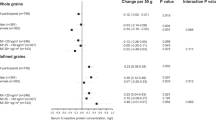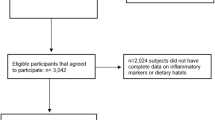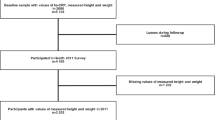Abstract
Objective: To examine whether diet quality is associated with C-reactive protein concentration.
Design: Cross-sectional study using data from the Third National Health and Nutrition Examination Survey (1988–1994).
Setting: Representative sample of the US population.
Subjects: A total of 13 811 men and women aged ≥20 y.
Interventions: We examined the cross-sectional associations between the Healthy Eating Index (HEI), a measure of diet quality according to the Dietary Guidelines for Americans, and serum C-reactive protein concentration. Dietary information was assessed using a 24-h recall.
Results: After adjustment for age, sex, race or ethnicity, education, smoking status, cotinine concentration, body mass index, waist-hip-ratio, aspirin use, alcohol use, physical activity level, and energy intake, HEI score was inversely associated with an elevated C-reactive protein concentration in logistic regression analysis (odds ratio per 10 unit change: 0.92; 95th confidence interval (CI): 0.86–0.99). Among the components, only the score for grain consumption was inversely associated with an elevated C-reactive protein concentration. Compared with participants in the lowest quintile of number of servings of grain consumption, the adjusted odds ratios of having an elevated C-reactive protein concentration for participants in the second, third, fourth, and fifth quintiles were 0.87 (95th CI: 0.67, 1.12), 0.85 (95th CI: 0.69, 1.06), 0.79 (95th CI: 0.65, 0.96), and 0.68 (95th CI: 0.52, 0.88), respectively.
Conclusions: Grain consumption may reduce inflammation. Our findings require confirmation.
Sponsorship: None.
This is a preview of subscription content, access via your institution
Access options
Subscribe to this journal
Receive 12 print issues and online access
$259.00 per year
only $21.58 per issue
Buy this article
- Purchase on Springer Link
- Instant access to full article PDF
Prices may be subject to local taxes which are calculated during checkout
Similar content being viewed by others
References
Centers for Disease Control and Prevention (1994): Plan and operation of the third National Health and Nutrition Examination Survey, 1988–94. Vital Health Stat 1, 1–407.
Centers for Disease Control and Prevention (1996): The Third National Health and Nutrition Examination Survey (NHANES III 1988-94) Reference Manuals and Reports (Materials on CD-ROM). Bethesda, MD: National Center for Health Statistics.
Chung HY, Kim HJ, Kim JW & Yu BP (2001): The inflammation hypothesis of aging: molecular modulation by calorie restriction. Ann. N.Y. Acad. Sci. 928, 327–335.
Ford ES (1999): Body mass index, diabetes, and C-reactive protein among U.S. adults. Diabetes Care 22, 1971–1977.
Ford ES & Liu S (2001): Glycemic index and serum high-density lipoprotein cholesterol concentration among US adults. Arch. Intern. Med. 161, 572–576.
Grimble RF (1999): Nutritional influences on inflammation. Nestle Nutrition Workshop Series Clinical Performance Programme 2, 63–77; discussion 77–81.
Hu FB & Willett WC (2002): Optimal diets for prevention of coronary heart disease. JAMA 288, 2569–2578.
Kennedy ET, Ohls J, Carlson S & Fleming K (1995): The Healthy Eating Index: design and applications. J. Am. Diet. Assoc. 95, 1103–1108.
Libby P (2002): Inflammation in atherosclerosis. Nature 420, 868–874.
Liu S (2002): Intake of refined carbohydrates and whole grain foods in relation to risk of type 2 diabetes mellitus and coronary heart disease. J. Am. Coll. Nutr. 21, 298–306.
Liu K, Stamler J, Dyer A, McKeever J & McKeever P (1978): Statistical methods to assess and minimize the role of intra-individual variability in obscuring the relationship between dietary lipids and serum cholesterol. J. Chron. Dis. 31, 399–418.
Liu HR, Tao L, Gao E, Christopher TA, Lopez BL, Yue TL & Ma XL (2003): Pro-inflammatory effects of hypercholesterolemia and anti-inflammatory effects of a peroxisome proliferator-activated receptor-gamma (PPAR) agonist. Acad. Emerg. Med. 10, 558–559.
Malpuech-Brugere C, Nowacki W, Daveau M, Gueux E, Linard C, Rock E, Lebreton J, Mazur A & Rayssiguier Y (2000): Inflammatory response following acute magnesium deficiency in the rat. Biochim. Biophys. Acta 1501, 91–98.
McCullough ML, Feskanich D, Stampfer MJ, Rosner BA, Hu FB, Hunter DJ, Variyam JN, Colditz GA & Willett WC (2000a): Adherence to the Dietary Guidelines for Americans and risk of major chronic disease in women. Am. J. Clin. Nutr. 72, 1214–1222.
McCullough ML, Feskanich D, Rimm EB, Giovannucci EL, Ascherio A, Variyam JN, Spiegelman D, Stampfer MJ & Willett WC (2000b): Adherence to the Dietary Guidelines for Americans and risk of major chronic disease in men. Am. J. Clin. Nutr. 72, 1223–1231.
Rahman I (2002): Oxidative stress, transcription factors and chromatin remodelling in lung inflammation. Biochem. Pharmacol. 64, 935–942.
Ridker PM (2003): Clinical application of C-reactive protein for cardiovascular disease detection and prevention. Circulation 107, 363–369.
Seaman DR (2002): The diet-induced proinflammatory state: a cause of chronic pain and other degenerative diseases? J. Manipulative Physiol. Ther. 25, 168–179.
Shah BV, Barnwell BG & Bieler GS (1997): SUDAAN User's Manual. Version 7.5. Research Triangle Park, NC: Research Triangle Institute.
Slavin JL, Jacobs D, Marquart L & Wiemer K (2001): The role of whole grains in disease prevention. J. Am. Diet Assoc. 101, 780–785.
Truswell AS (2002): Cereal grains and coronary heart disease. Eur. J. Clin. Nutr. 56, 1–14.
US Department of Health and Human Services (DHHS) (1999): National Center for Health Statistics. Third National Health and Nutrition Examination Survey, 1988–1994, NHANES III Healthy Eating Index Data File (Series 11, No. 6A). Hyattsville, MD.: Centers for Disease Control and Prevention.
Willett WC (1998): Nutritional Epidemiology 2nd Edition. New York: Oxford University Press.
Author information
Authors and Affiliations
Corresponding author
Additional information
Guarantor: E Ford.
Contributors: ESF conceived of the topic of the paper, conducted the analyses, and wrote the paper. AHM and SL participated in the planning of the analyses. AHM and SL reviewed the paper for critical content.
Rights and permissions
About this article
Cite this article
Ford, E., Mokdad, A. & Liu, S. Healthy Eating Index and C-reactive protein concentration: findings from the National Health and Nutrition Examination Survey III, 1988–1994. Eur J Clin Nutr 59, 278–283 (2005). https://doi.org/10.1038/sj.ejcn.1602070
Received:
Revised:
Accepted:
Published:
Issue Date:
DOI: https://doi.org/10.1038/sj.ejcn.1602070
Keywords
This article is cited by
-
Dietary approach to stop hypertension and healthy eating index 2015, modify the association between FTO polymorphisms and obesity phenotypes
BMC Research Notes (2023)
-
The Use of Healthy Eating Index 2015 and Healthy Beverage Index for Predicting and Modifying Cardiovascular and Renal Outcomes
Current Nutrition Reports (2022)
-
Dietary patterns and associations with biomarkers of inflammation in adults: a systematic review of observational studies
Nutrition Journal (2021)
-
A Dietary Inflammatory Index and associations with C-reactive protein in a general adult population
European Journal of Nutrition (2021)
-
Influence of Lifestyle Factors on Inflammation in Men and Women with Type 2 Diabetes: Results from the National Health and Nutrition Examination Survey, 1999–2004
Annals of Behavioral Medicine (2012)



